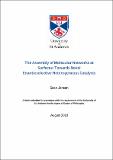The assembly of molecular networks at surfaces : towards novel enantioselective heterogeneous catalysts
Abstract
Understanding the supramolecular interactions governing the self-assembly of molecular building blocks upon surfaces is fundamental to the design of new devices such as sensors or catalysts. Successful heterogeneous enantioselective catalysts have relied upon the adsorption of ‘chiral modifiers’, usually chiral amino acids, onto reactive metal surfaces. One of the most researched examples is the hydrogenation of β-ketoesters using nickel-based catalysts. The stability of the chiral modifiers upon catalyst surfaces is a major obstacle to the industrial scale-up of this reaction. In this study, the replacement of conventional modifiers with porous, chiral and functionalised self-assembled networks is investigated.
Perylene-3,4,9,10-tetracarboxylic diimide (PTCDI) and melamine (1,3,5-triazine,-2,4,6-triamine) have been shown to form hydrogen bonded networks on Ag-Si(111)√3x√3R30° in ultra-high vacuum (UHV) and Au(111) substrates in UHV and ambient conditions, these networks are capable of hosting guest molecules. These networks are investigated further in this study. In UHV, the behaviour of the components and network formation on Ni(111) is probed using scanning tunnelling microscopy (STM) and temperature-programmed desorption (TPD). The stability of the PTCDI-melamine network on Au(111) was analysed using TPD. Metal coordination interactions between each of the network components and nickel upon the Au(111) surface were examined by STM before testing the ability of the network to act as a template for metal growth.
Finally, a number of polymerisation reactions are investigated with a view to replacing chiral modifiers with porous, chiral, functionalised covalent networks. Periodic covalent networks should possess the greater chemical and thermal stability required for more widespread use. In UHV and ambient conditions, STM is used to monitor the progress of surface-confined reactions on Au(111) and characterise the resultant covalent structures.
Type
Thesis, PhD Doctor of Philosophy
Collections
Items in the St Andrews Research Repository are protected by copyright, with all rights reserved, unless otherwise indicated.

